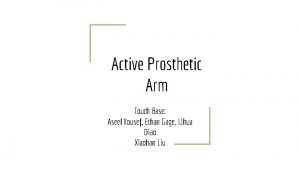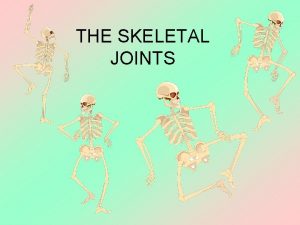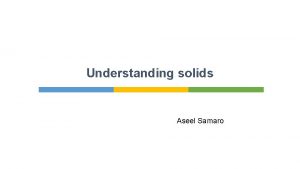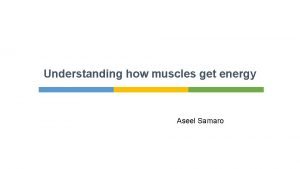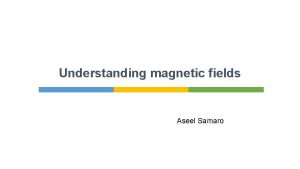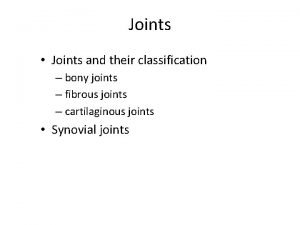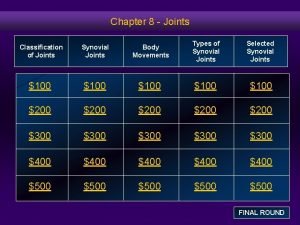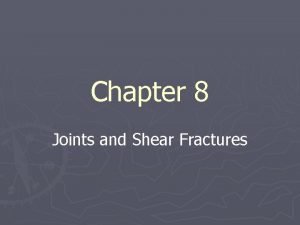Understanding the role of skeletal joints Aseel Samaro



















- Slides: 19

Understanding the role of skeletal joints Aseel Samaro


Understanding the role of skeletal joint § They all use hinges to move § Your body has a hinge joints which work in a similar way to hinges on a door or gate. § The elbows and knees are example of hinge joints.

Understanding the role of skeletal joint § Bones meet at joints. § Some joints, such as those in your cranium, do not allow much movement. § However, many joints allow a wide range of movement. Try moving your arm at your elbow, then try at your shoulder. Different joints allow you to move in different ways.

The bones of a skeleton are held together by ligaments. Bones are connected to muscles by tendons.


§ Both ligaments and tendons are made of stretchy fibres called collagen. § However, the fibres are arranged differently in each: ü In tendons, they are arranged so that the tendon can move easily as muscles contract. üIn ligaments, fibres are arranged more tightly to hold bones together securely.

Explain why it is important that tendons are stretchy.

To allow muscles to contract

Are all joints the same ? § We have three types of moveable joints. § The range and type of movement that they allow varies. § Fixed joints, such as those in the skull, do not allow movement.

Ball and socket joints § Ball and socket joints allow forward, backward and circular movements. § The shoulder joint is a ball and socket.

Hinge joint § A hinge joint allows movement like the opening and closing of a door. § This type of joint is found at the elbow.

Pivot Joint § A pivot joint allows rotation around an axis. § This type of joint is found at the top of the neck and allows you to move your head from side to side.

WORKSHEET

Suggest which type of joint is found in the: §Hip §Knee

A team effort § Most movements are more complex than simply moving at one joint. § For example, throwing a ball could involve: ü the shoulder joint to lift the ball üthe elbow joint to bend the arm üthe finger joints to let go of the ball. § You will co-ordinate movements of these joints without even realising it.

§ Without the ability to move our skeleton, our ability to survive would severely diminished. § We can move and manipulate objects very accurately as we have a lot of different types of joints, perfected for different movements. § The carpometacarpal joint of the thumb is a saddle joint and is exceptionally important for gripping objects

Diseases of the joints § Diseases of the joints can be very painful and debilitating § Rheumatoid arthritis is a disease which affects joints. § It causes joint pain, swelling and limits the motion of the joints

 How to identify pure aseel
How to identify pure aseel Aseel yousef
Aseel yousef Lab samaro
Lab samaro Samaro property
Samaro property Lab samaro
Lab samaro Lab samaro
Lab samaro Understanding the role of culture
Understanding the role of culture Worker role azure
Worker role azure Role making krappmann
Role making krappmann Role conflict occurs when fulfilling the role expectations
Role conflict occurs when fulfilling the role expectations Chụp tư thế worms-breton
Chụp tư thế worms-breton Tư thế ngồi viết
Tư thế ngồi viết ưu thế lai là gì
ưu thế lai là gì Voi kéo gỗ như thế nào
Voi kéo gỗ như thế nào Thẻ vin
Thẻ vin Thơ thất ngôn tứ tuyệt đường luật
Thơ thất ngôn tứ tuyệt đường luật Các châu lục và đại dương trên thế giới
Các châu lục và đại dương trên thế giới Từ ngữ thể hiện lòng nhân hậu
Từ ngữ thể hiện lòng nhân hậu Diễn thế sinh thái là
Diễn thế sinh thái là Frameset trong html5
Frameset trong html5

